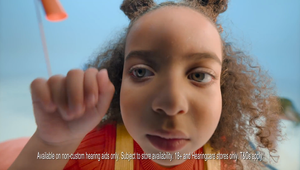
How Canon’s ‘World Unseen’ Exhibition Heightens Art through Accessibility

Above: 'Rhino Wars' by Brent Stirton.
Globally, 2.2 billion people have some form of visual impairment, which puts up barriers to appreciating photography. The ‘World’ Unseen’ exhibition removed these barriers as an exhibition designed with the experience of blind and partially sighted people in mind.
The exhibited work by world-renowned photographers was accompanied with elevated prints, audio descriptions, soundscapes and braille for a tactile experience that helps visitors connect with these powerful images and the stories they tell. It’s also presented in a gorgeous online gallery with as many layers of accessibility built in as are possible on that space too.
The exhibition included works from photographers and Canon ambassadors from around the globe, including multi-award-winning South African photojournalist Brent Stirton, renowned Brazilian photojournalist Sebastião Salgado, Nigerian photojournalist Yagazie Emezi, sports photographer Samo Vidic, fashion photographer Heidi Rondak and Pulitzer winning photojournalist Muhammed Muheisen.

An accompanying video series featured partially sighted individuals, including British disability activist, Lucy Edwards, and Menna Fitzpatrick MBE, Britain’s most decorated Winter Paralympian, who have collaborated with Canon to tell their stories and show their reaction to experiencing this photography for the first time.
“It essentially changes the way blind and partially-sighted people experience photography,” says creative director at VML UK, San Sharma. “It also changes the way sighted people better understand the visual impairment experience.” San has spent over a year on this campaign and he admits that he didn’t appreciate the variation in sightedness that exists. Now understands the breadth of experience – which is something the exhibition gives us a perspective on too. “There isn't a singular blind or partially sighted experience,” says San. “So this is really a conversation about how diverse accessibility needs are even within the blind community.”

Besides making an exhibition accessible to more people, the art was all the richer for these added dimensions. Sighted people can gain a better appreciation of the partially sighted experience from this kind of event. Each image was obscured in different ways to convey different types of visual impairment, from glaucoma to diabetic retinopathy.
The great thing is that walking around the exhibition, you can see new standards emerging that any other collection of work could apply in order to open up and enrich the experience. San notes the progress that accessibility needs have broken new ground on, which all of us use. “The thing about inclusive design is when you design for one, you design for all. Great accessible, inclusive design is something that you and I use all the time. Text messaging was made for people with accessibility needs, subtitles on TVs that I use all time because I can't hear Chris Nolan's dialogue. We all benefit from pushing accessibility.”
Beyond that, there’s a textural richness that the layers of accessibility bring to the art. “Experiencing this as a sighted person, I'm enjoying the photography in a different way,” says San. “I'm working harder to see it and appreciate it. I've got the soundscapes with audio descriptions, the relief is really interesting. It's a much more immersive experience for everyone. So by doing this for a community of people who have an accessibility need, we make it better for everyone.”
One piece, ‘Chloe Kelly’ by Marc Aspland, is a triptych replaying the action of a decisive goal for the England team captured during the UEFA Women’s European Championship final in 2022. The images contain an abundance of players’ and fans’ bodies, so the creative decisions around what is picked out in the relief version is interesting to analyse. “It’s simulating what the mind might focus on,” says San. “You draw attention to certain players, so they get more attention in the relief. So I think it makes it much more immersive.”

The audio descriptions are also a fascinating way to experience the photographs. “This community is used to very functional audio descriptions – ‘man walks into a room and sits down’. And what's sometimes lacking is the context behind the photograph, the emotion, the political, cultural situation around the photography, how the photographer was feeling,” says San. “This gives everyone a much more emotive description, which is much more immersive. And the soundscapes make it feel like you're right there. So it's not accessibility as function, it's accessibility as art, which I think is a beautiful thing to do for everyone.”
For VML, working with Canon and the RNIB has allowed the agency to learn lessons that it will draw on in the months and years to come, as inclusive design becomes more heavily enforced for businesses. “Brands and agencies are sometimes so afraid of getting it wrong that they don't start,” warns San. “And I think it's best to start and ask rather than not start at all. That's why it's been so great to work with the RNIB because you've got a sounding board for how to work with people with lived experience so that we can continually check whether we're doing the right thing. I think we need to go into it with the thinking that you might not get it right the first time but you've got to start and try to get it right and fix it when it goes wrong.”
Canon has also laid down something of a gauntlet to other image-making brands. “I think accessibility is an area where a bit of competition is good,” says San. “When Canon sees other brands doing stuff like this, they're like, ‘great, well done, let's go again, let's go even further.’ Because everyone benefits when people compete.”
For cultural and artistic spaces like Somerset House, it’s also a reminder of ways that they can be more welcoming for people with different accessibility needs. “It makes that community feel more seen,” says San. “To have places like this where they feel they can come and get just as much out of art and photography as people with sight can.”
















